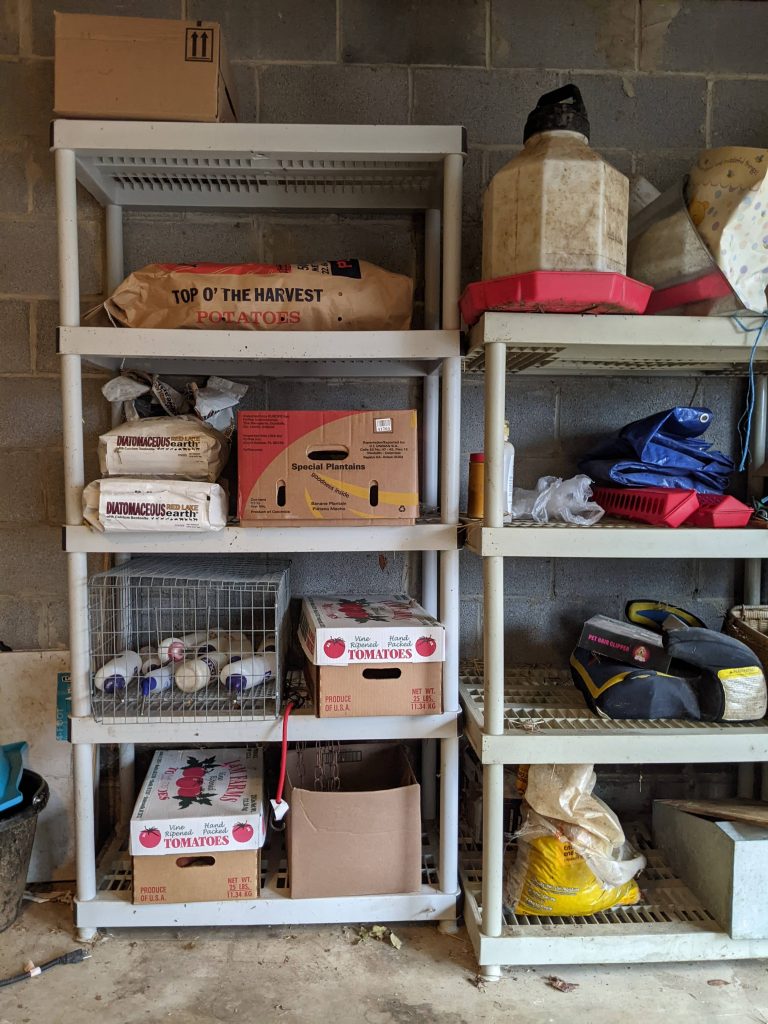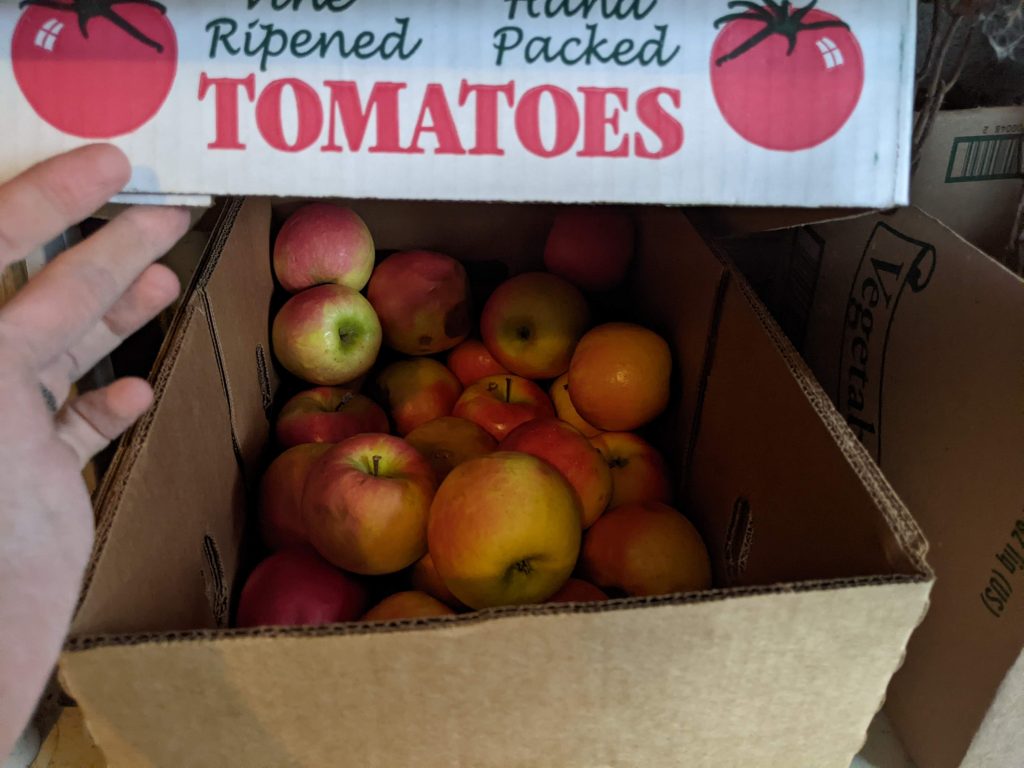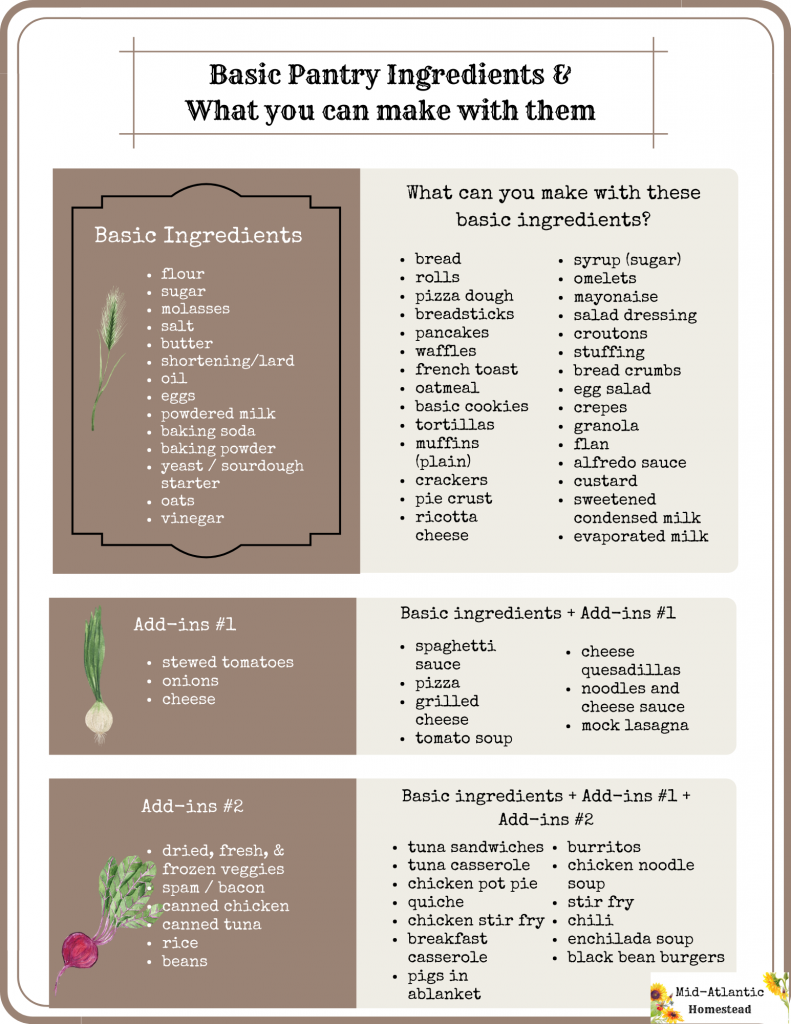Our Family’s Story
At church one Sunday I heard some friends talk about trying to do a “no grocery shopping for a month” challenge. I was intrigued and gradually started seeing how long we could stretch the time between our trips to the grocery store. That was about 10 years ago.
I started by only being able to go 10 days and then a couple weeks.
A lot has changed since I did my first no grocery shopping challenge. Back then, we were a family of four living in a little home on a third of an acre and a few raised beds. Our little kitchen did not have much storage space, but with careful planning we were able to store a month of food.



Now we live on over 5 acres, raise nearly all of our own meat, can more than 500 quarts of food each year along with freezing and dehydrating our garden produce. Little by little we are gradually making progress on our self sufficiency goals.
Pssst! If you’re interested in preparedness and greater self sufficiency, I recommend my Pantry Inventory Workbook. It can help you organize your current supplies and assess what you might be missing for a YEAR supply of food and household items.



Every year for the past 8 years or so, January has been a “no-shopping month” for us. It is like my annual re-set after the gluttony of the holidays. Over the last 3-4 years I have been working on extending our “no-shopping” period to 3 months. With all these years of gradual practice we can now easily go 1 month without going to the grocery store.
I dehydrate, pressure can, and freeze a lot of fruits, veggies, soups, and stews. I have also learned how to store fresh fruits and veggies so that they last a lot longer. Even though I have not been to the store for almost 2 months, we still have fresh apples, pears, and potatoes in our “cold storage” aka the garage.



Each family’s short term preparedness supplies will look different based on what your family likes to eat. And your pantry storage should reflect the kinds of meals that you actually like to eat, not an arbitrary list. That way you will naturally rotate through your supplies, adding more as you use them.
What do I really need to have on hand to make it through a month without grocery shopping?
My basic pantry ingredient list is still the same as it was when we were in our first little home. As long as I have plenty of these basic ingredients, I know that I can make do with whatever add-ins we have on hand. The list of add-ins could go on and on. These are just a couple of examples.
It’s important to note though — we cook from scratch even more than usual during no grocery shopping months. For example, we use about 50 lbs of white flour and 25 lbs of wheat per month during our no shopping periods. We use about half that much per month at other times of year. When the kids are looking for snacks I encourage them to practice their baking skills. The older two are able to very independently choose recipes and bake them. The middle two still need some hand-holding when they want to bake snacks. Not having any pre-made snacks in the house is very motivational for young bakers to practice their skills.

Why I like not grocery shopping for a month
- Use and rotate existing pantry and freezer storage — we try to have 3 months of short-term pantry storage on hand. Eating from it for a month helps me see what kinds of things our family actually wants to eat and helps us rotate through it rather than wasting anything. Also, I am not good at keeping inventory lists of what we have. The no shopping month forces me to really dig in and get to know what I have on my pantry and freezer shelves.
- Store what we like — as above, forcing ourselves to eat from storage is the ultimate test of how much we need and what types of foods. We realized, for example, that we need about twice as much canned, dried, and frozen fruit when we are not out buying fresh fruit every week or two.
- Save $ — not grocery shopping for a month saves money because you make fewer impulse purchases and use up things that have been hanging out in the freezer or that might otherwise go to waste. For example, I have lots of frozen kale, squash, and mincemeat pie filling in the freezer from the summer garden’s bounty. I do a much better job incorporating those into our meals when I have fewer options to work with.
- Change our habits — This is the big bonus of the no shopping month. It is forced frugality for a month that then leads to a natural change in perspective. You appreciate what you have more, treat your resources more respectfully, and end up with a more frugal attitude than when you started.
My suggestions to help anyone interested in trying this get off to a good start:
- Cover the basics — Before I start a no shopping month, I go through my basic ingredient list (as shown above). I made the chart to try to illustrate the way that I conceptualize my basic ingredient storage. If I have those things then I know that I can make all the things listed in the right column. And with each additional set of “add-ins” my list of meal options grows.
- Make things from scratch – If you know that you cannot live without pop-tarts for a month, then you should probably have 10 boxes of them in your short-term storage at all times. But honestly, for the no-shopping month to work well it requires some cooking from scratch. For example, you can buy bread from the store and keep it in the freezer, but it really is so much yummier and cheaper to just make a loaf every few days. There are some great books/blogs/youtube videos out there to help with this.
- Get creative – I think this is my favorite part of the no shopping month. It forces me to make substitutions and get creative with my cooking. As the saying goes, “Necessity is the mother of invention”. And of course, if you are not feeling creative, you can always search for recipes by ingredients you have on hand.
- Reward Yourselves – I should have listed a Costco size bag of chocolate chips in my basics category. Haha! :) I always keep a few treats squirreled away for the end of the month when things get boring and repetitive. Like a package of pepperoni for pizza night the last week. It helps us get through the last 10 days with flare.
- Food storage Wish List & Restock – The wish list and restocking are critical for the next no grocery shopping month and improving the short term storage overall. Every time I WISH I had some ingredient, I add it to my food storage wish list. Usually, things on my wish list are kinda quirky. I would not have thought of having a case of coconut milk or a pound of frozen ginger root in my food storage, but during a recent month of no shopping I had so many things that I could have made with those two additions. The wish list also helps me know what things to buy more of — the stores are depleted after using them for a month – note all the things that need to be restocked and how many.




Leave a Reply